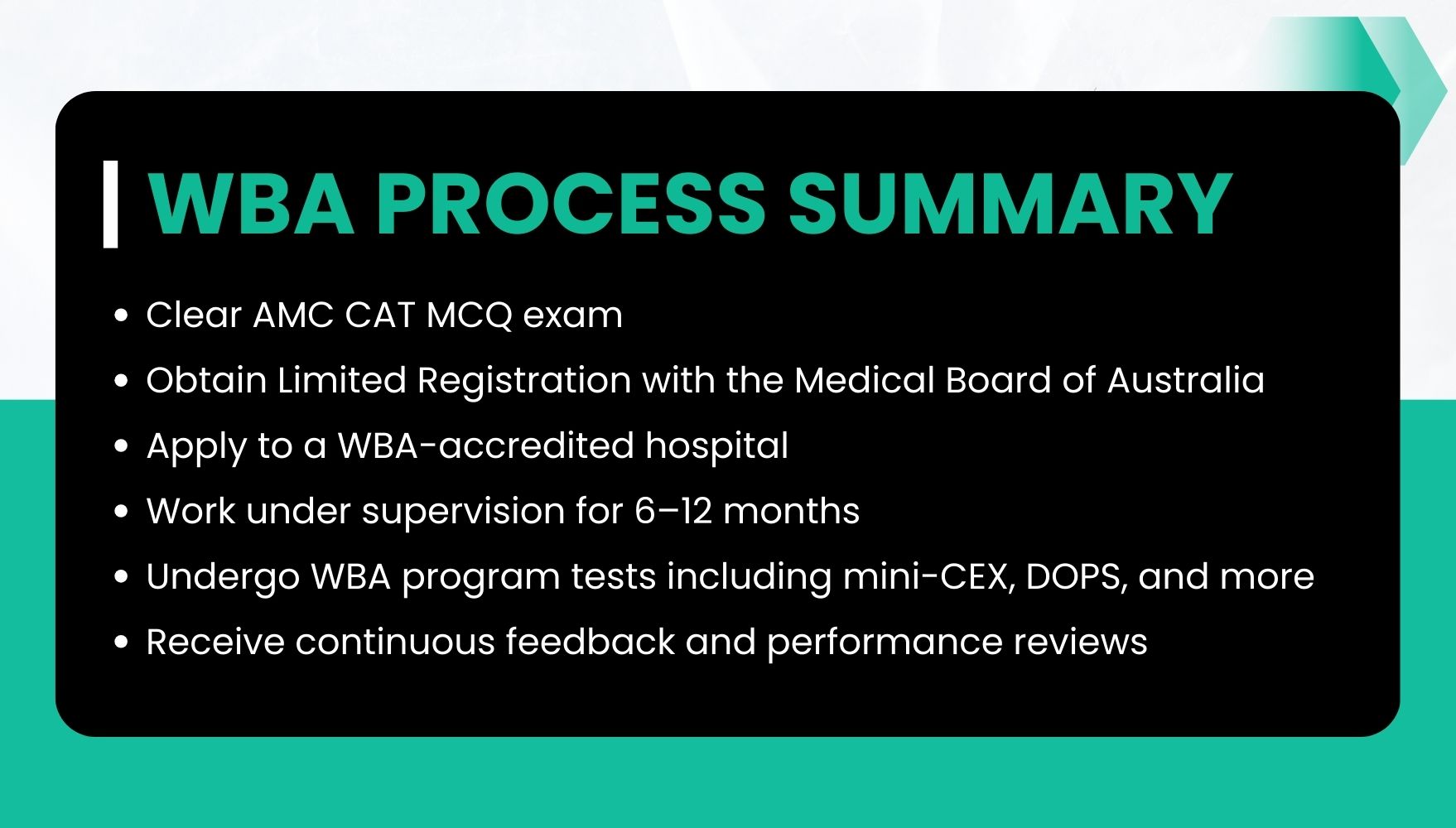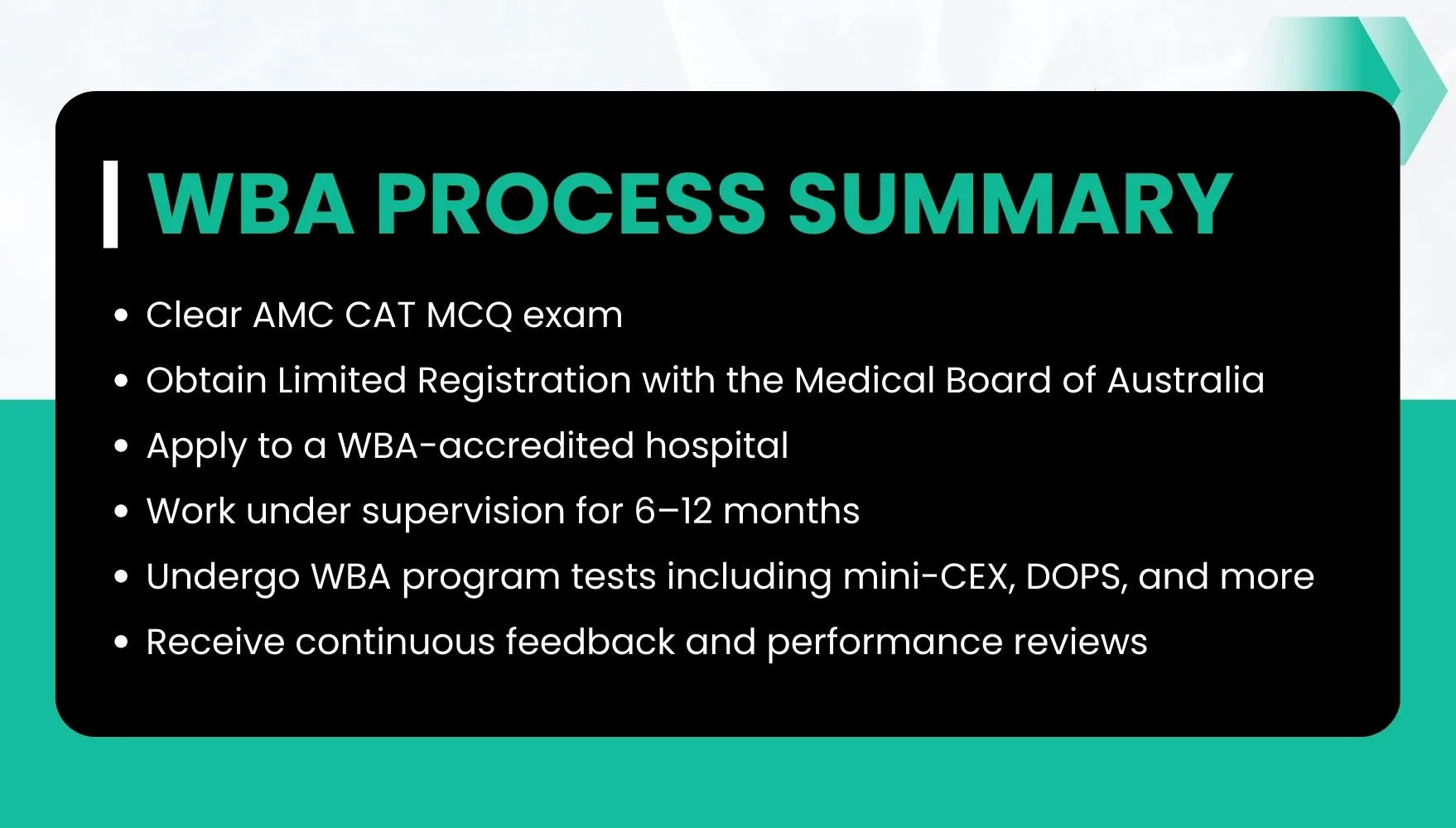What is a Workplace Based Assessment (WBA) Pathway?
The Workplace Based Assessment (WBA) pathway is an alternative option to the AMC Clinical Exam for international medical graduates (IMGs). This is for those who have already cleared the AMC CAT MCQ exam. In this, instead of appearing for a clinical test, you get assessed on the job, over a period of time, while working in an Australian clinical environment under supervision.
In simple terms, WBA is a series of mini-assessments done in real-time, in real hospitals or clinics, with real patients. It gives you the opportunity to show what you’re capable of, not in a simulated exam room, but in actual day-to-day practice.

What is the Eligibility for WBA?
To be eligible for WBA, IMGs must have:
- Passed AMC CAT MCQ examination
- Be granted limited registration by the Medical Board of Australia
- Have an appointed position in a hospital or general practice position with a contract for the full duration of the program
What is tested in WBA?
The WBS tests the IMGs application of knowledge and clinical skills in the clinical setting. A WBA program assesses the following aspects:
- Clinical skills (like history taking, physical examination, investigations and diagnosis, prescribing and management, counselling/patient education, clinical procedures)
- Clinical judgment
- Communication skills
- Ability to work as an effective member of the healthcare team
- Ability to apply aspects of public health relevant to clinical settings
- Indigenous health and cultural competence
- Professionalism
- Patient safety
WBA Programs Accredited by AMC
| Program provider | Location |
| Armadale Kalamunda Group | Armadale Health Service, Western Australia |
Central Coast Local Health District | Gosford, Wyong, Woy Woy Hospitals, New South Wales |
| Central Queensland Hospital and Health Service | Rockhampton Hospital, Gladstone Hospital, Queensland |
| Darling Downs Hospital and Health Service | Toowoomba Hospital, Queensland |
| Gold Coast Hospital and Health Service | Gold Coast University Hospital & Robina Hospital, Queensland |
| Hunter New England Local Health District | Newcastle, Armidale, Tamworth and Taree, New South Wales |
| Illawarra Shoalhaven Local Health District | Shellharbour, Bulli, Port Kembla, Coledale, Wollongong and Shoalhaven Hospitals |
| Joondalup Health Campus | Joondalup Health Campus, Western Australia |
| Latrobe Regional Hospital | Latrobe Regional Hospital, Victoria |
| Limestone Coast Local Health Network | Mount Gambier Hospital, South Australia |
| Mackay Hospital and Health Service | Mackay Base Hospital, Queensland |
| Metro North Hospital and Health Service | Caboolture Hospital, Queensland |
| Monash Health | Monash Medical Centre, Victoria |
| Mildura Base Public Hospital | Mildura Base Public Hospital, Victoria |
| Mid North Coast Local Health District | Kempsey District Hospital (with some support from Port Macquarie Base Hospital) and Coffs Harbour Health Campus, New South Wales |
| Nepean Blue Mountains Local Health District | Nepean Hospital, New South Wales |
| Northern Adelaide Local Health Network | Lyell McEwin Hospital, Modbury Hospital, South Australia |
| Northern NSW Local Health District – Richmond Medical Workforce | Lismore Base Hospital, Casino and District Memorial Hospital, Ballina Hospital, Kyogle Memorial Hospital, New South Wales |
| Rockingham General Hospital | Rockingham General Hospital, Western Australia |
| Sunshine Coast Hospital and Health Service | Sunshine Coast University Hospital, Nambour Hospital, Gympie Hospital, Maleny Hospital and Caloundra Hospital, Queensland |
| South Western Sydney Local Health District | Campbelltown, Bankstown, Bowral and Fairfield Hospitals, New South Wales |
| Tasmanian Health Service | Launceston General Hospital; North West Regional Hospital, Burnie; Mersey Community Hospital, Latrobe and Royal Hobart Hospital, Tasmania |
| WA Country Health Service | Bunbury, Geraldton and Kalgoorlie, Western Australia |
| Western Sydney Local Health District | Blacktown Hospital and Mount Druitt Hospital, New South Wales |
| Wide Bay Hospital and Health Service | Hervey Bay, Bundaberg and Maryborough Hospitals, Queensland
|
How Does the WBA Pathway Work?
Here’s how it goes:
- Apply to a WBA-accredited hospital (only a few hospitals in Australia run this program).
- Once accepted, you’ll begin working in a supervised clinical role for around 6 months
- During this period, you’ll be assessed by experienced clinicians using various tools like:
- Mini-CEX (Mini Clinical Evaluation Exercises)
- DOPS (Direct Observation of Procedural Skills)
- CBD (Case-Based Discussions)
- Multi-source Feedback (360° Feedback)
- Structured supervision reports
Benefits of the WBA Pathway
Still wondering whether WBA is the right choice for you? Here are some advantages to consider:
- No More Simulated Exams: Say goodbye to OSCEs! You’ll be assessed in real clinical situations.
- Earn While You Learn: You’ll be working and earning during the WBA program.
- Continuous Feedback: Instead of a single exam result, you get ongoing feedback to improve along the way.
- Path to General Registration: Successful completion of WBA can lead you directly to general registration with the Medical Board of Australia.
Final Thoughts
The WBA pathway is an excellent option for IMGs who prefer a more practical, workplace-focused way to prove their clinical skills. If you’ve already cleared the AMC MCQ exam and feel confident working in real clinical settings, this could be the perfect path to start your medical career in Australia.
So, why wait?
Explore WBA-accredited hospitals, get your documents ready, and take the next step toward becoming a doctor in Australia, one real patient at a time.
If you are looking for guidance on becoming a doctor in Australia, fill out this form. Our expert team will guide you through every step of the process.




